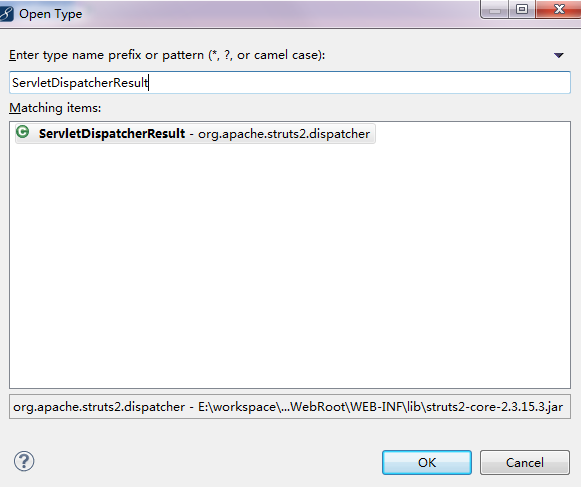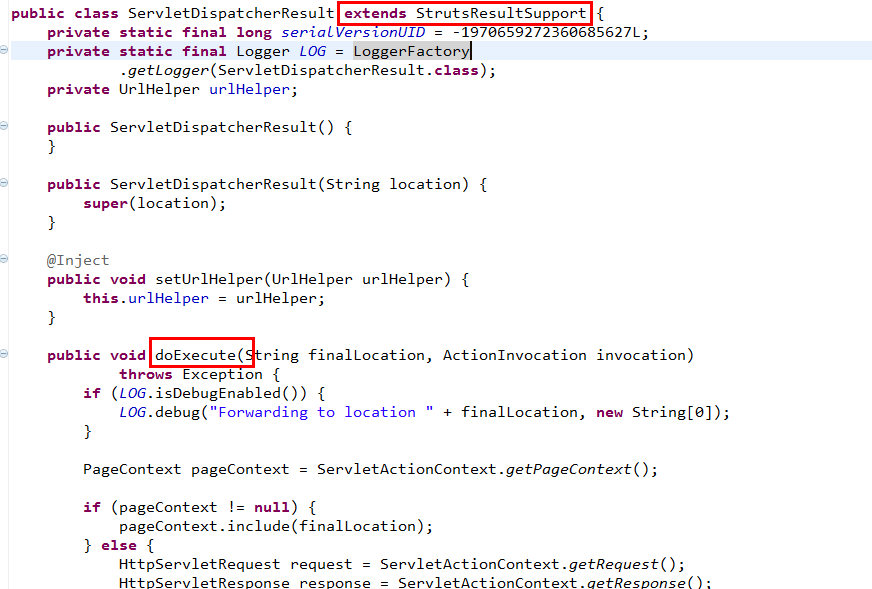自定义结果类型(result的type属性)
2016-07-03 20:22
585 查看
需求:
自定义一个结果类型,用于自动生成验证码,生成验证需要借助一个第三方工具validatecode.jar,当然也可以自己实现
分析:
要想实现一个自定义的结果类型,那么,我们可以参考struts2官方是如何实现现有的结果类型的。我们在struts.xml中定义package元素的时候,一般会继承一个struts-default.xml的文件,这个文件中包含了struts2里的很多核心内容,结果类型也在其中。我们可以在struts2的核心jar包中找到这个文件,打开来参考一下。我这里以struts2-core-2.3.15.3.jar为例:

用解压软件打开这个jar包,在根目录下,就可以找到这个struts-default.xml文件,再次打开这个文件,找到我们要的result-types定义的地方:
以上可以看出,struts2提供了这些结果类型。
我们现在要自定义一个结果类型,那么,就可以参照这里的结果类型进行定义,我们以默认的结果类型dispatcher为例,我们看到它的实现类为org.apache.struts2.dispatcher.ServletDispatcherResult
在myeclipse中,ctrl+shift+t 找到这个类

分析这个类,我们看到,这个类主要有两点,继承了一个类为StrutsResultSupport,实现了里面的deExecute()方法,在方法中,实现了视图的输出

于是,我们得出,我们的自定义结果类型也可以如此来实现。
返回结果的使用,这里就不缀述了,既然找到方法了,那么,下面就开始动手吧。
详细步骤:
我们新建一个页面,这个页面只是为了显示验证码,就不再做任何的业务了。
在这个页面中,我们生成验证码是访问的一个action,最核心的就只有这一句:
验证码:
既然要访问这个action,那么我们就来写这个action,这个action没有任何写的,就是一个普通的action,里面的getCode()方法直接返回success
这样做的目的就是在使用时,直接使用result的type属性来指定我们自定义的返回结果类型,用这个返回结果类型来输出验证码。所以,下一步就是要定义我们的重头戏:自定义返回结果类型:
我们来定义好我们的返回结果类型:继承类StrutsResultSupport,实现里面的deExecute()方法,在方法中,实现视图的输出
在自定义CodeResult中,我们可以提供一些参数,并为这些参数都提供setter方法,那么在使用的时候,就可以在struts.xml中的Action > result 下,使用param标签注入值,这样使用我们的返回结果类型更加灵活
OK,现在自定义的返回结果类型CodeResult已经有了,那么就是使用了
在struts.xml中,使用result-types标签来引用自定义的返回结果类型
然后,在定义action的result时,就可能指定type为自定义的返回结果类型了,同时,由于我们自定义返回结果类型时,还提供了一些参数,那么,也可以使用param标签对这些参数进行注入
完整的struts.xml如下:
最后,一定不要忘记在web.xml中注册struts2哈
最后,部署到tomcat,验证一下结果:

自定义一个结果类型,用于自动生成验证码,生成验证需要借助一个第三方工具validatecode.jar,当然也可以自己实现
分析:
要想实现一个自定义的结果类型,那么,我们可以参考struts2官方是如何实现现有的结果类型的。我们在struts.xml中定义package元素的时候,一般会继承一个struts-default.xml的文件,这个文件中包含了struts2里的很多核心内容,结果类型也在其中。我们可以在struts2的核心jar包中找到这个文件,打开来参考一下。我这里以struts2-core-2.3.15.3.jar为例:

用解压软件打开这个jar包,在根目录下,就可以找到这个struts-default.xml文件,再次打开这个文件,找到我们要的result-types定义的地方:
<result-types> <result-type name="chain" class="com.opensymphony.xwork2.ActionChainResult"/> <result-type name="dispatcher" class="org.apache.struts2.dispatcher.ServletDispatcherResult" default="true"/> <result-type name="freemarker" class="org.apache.struts2.views.freemarker.FreemarkerResult"/> <result-type name="httpheader" class="org.apache.struts2.dispatcher.HttpHeaderResult"/> <result-type name="redirect" class="org.apache.struts2.dispatcher.ServletRedirectResult"/> <result-type name="redirectAction" class="org.apache.struts2.dispatcher.ServletActionRedirectResult"/> <result-type name="stream" class="org.apache.struts2.dispatcher.StreamResult"/> <result-type name="velocity" class="org.apache.struts2.dispatcher.VelocityResult"/> <result-type name="xslt" class="org.apache.struts2.views.xslt.XSLTResult"/> <result-type name="plainText" class="org.apache.struts2.dispatcher.PlainTextResult" /> </result-types>
以上可以看出,struts2提供了这些结果类型。
我们现在要自定义一个结果类型,那么,就可以参照这里的结果类型进行定义,我们以默认的结果类型dispatcher为例,我们看到它的实现类为org.apache.struts2.dispatcher.ServletDispatcherResult
在myeclipse中,ctrl+shift+t 找到这个类

分析这个类,我们看到,这个类主要有两点,继承了一个类为StrutsResultSupport,实现了里面的deExecute()方法,在方法中,实现了视图的输出

于是,我们得出,我们的自定义结果类型也可以如此来实现。
返回结果的使用,这里就不缀述了,既然找到方法了,那么,下面就开始动手吧。
详细步骤:
我们新建一个页面,这个页面只是为了显示验证码,就不再做任何的业务了。
在这个页面中,我们生成验证码是访问的一个action,最核心的就只有这一句:
验证码:
<input/><img alt="验证码" src="${pageContext.request.contextPath}/verifycode.action">既然要访问这个action,那么我们就来写这个action,这个action没有任何写的,就是一个普通的action,里面的getCode()方法直接返回success
package demo.action;
import com.opensymphony.xwork2.ActionSupport;
/**
* 验证码获取Action
* @author Minhellic
*
*/
public class VerifyCodeAction extends ActionSupport {
/**
* 这里直接返回,验证码通过返回的type来获取
* @return
*/
public String getCode() {
return SUCCESS;
}
}这样做的目的就是在使用时,直接使用result的type属性来指定我们自定义的返回结果类型,用这个返回结果类型来输出验证码。所以,下一步就是要定义我们的重头戏:自定义返回结果类型:
我们来定义好我们的返回结果类型:继承类StrutsResultSupport,实现里面的deExecute()方法,在方法中,实现视图的输出
在自定义CodeResult中,我们可以提供一些参数,并为这些参数都提供setter方法,那么在使用的时候,就可以在struts.xml中的Action > result 下,使用param标签注入值,这样使用我们的返回结果类型更加灵活
package demo.results;
import java.awt.image.BufferedImage;
import javax.imageio.ImageIO;
import javax.servlet.http.HttpServletResponse;
import org.apache.struts2.ServletActionC
4000
ontext;
import org.apache.struts2.dispatcher.StrutsResultSupport;
import cn.dsna.util.images.ValidateCode;
import com.opensymphony.xwork2.ActionInvocation;
/**
* 自定义Result:
* 1.直接或间接地实现接口com.opensymphony.xwork2.Result,这里采用的是继承StrutsResultSupport类
* 2.重写doExcute()方法,在该方法中实现视图的输出
* @author Minhellic
*
*/
public class CodeResult extends StrutsResultSupport {
private int width = 120;//验证码宽
private int height = 80;//验证码高
private int codeCount = 4;//验证码字符数
private int lineCount = 100;//干扰线条数
/*
* 为每个属性添加set方法,以方便可以在struts.xml中的Action > result 下,使用param标签注入值
*/
public void setWidth(int width) {
this.width = width;
}
public void setHeight(int height) {
this.height = height;
}
public void setCodeCount(int codeCount) {
this.codeCount = codeCount;
}
public void setLineCount(int lineCount) {
this.lineCount = lineCount;
}
/**
* 重写父类的方法,以向页面输出验证码
*/
@Override
protected void doExecute(String arg0, ActionInvocation arg1)
throws Exception {
//借用第三方工具包ValidateCode.jar生成验证码
ValidateCode vc = new ValidateCode(width, height, codeCount, lineCount);
BufferedImage bi = vc.getBuffImg();
//得到响应并输出
HttpServletResponse response = ServletActionContext.getResponse();
ImageIO.write(bi, "jpeg", response.getOutputStream());
}
}OK,现在自定义的返回结果类型CodeResult已经有了,那么就是使用了
在struts.xml中,使用result-types标签来引用自定义的返回结果类型
<!-- 引用自定义的返回类型 --> <result-types> <result-type name="code" class="demo.results.CodeResult"></result-type> </result-types>
然后,在定义action的result时,就可能指定type为自定义的返回结果类型了,同时,由于我们自定义返回结果类型时,还提供了一些参数,那么,也可以使用param标签对这些参数进行注入
<!-- action定义 --> <action name="verifycode" class="demo.action.VerifyCodeAction" method="getCode"> <!-- 在result中,使用type属性指定返回的类型为自定义的code,如果不指定,会是dispatcher --> <result name="success" type="code"> <!-- 由于自定义的返回类型中,对这些属性提供了set方法,所以这里可以使用param标签注入值 --> <param name="width">300</param> <param name="height">30</param> <param name="codeCount">5</param> <param name="lineCount">30</param> </result> </action>
完整的struts.xml如下:
<?xml version="1.0" encoding="UTF-8"?>
<!DOCTYPE struts PUBLIC
"-//Apache Software Foundation//DTD Struts Configuration 2.3//EN"
"http://struts.apache.org/dtds/struts-2.3.dtd">
<struts>
<package name="demo" extends="struts-default">
<!-- 引用自定义的返回类型 --> <result-types> <result-type name="code" class="demo.results.CodeResult"></result-type> </result-types>
<!-- action定义 --> <action name="verifycode" class="demo.action.VerifyCodeAction" method="getCode"> <!-- 在result中,使用type属性指定返回的类型为自定义的code,如果不指定,会是dispatcher --> <result name="success" type="code"> <!-- 由于自定义的返回类型中,对这些属性提供了set方法,所以这里可以使用param标签注入值 --> <param name="width">300</param> <param name="height">30</param> <param name="codeCount">5</param> <param name="lineCount">30</param> </result> </action>
</package>
</struts>
最后,一定不要忘记在web.xml中注册struts2哈
<!-- struts2的核心过滤器 --> <filter> <filter-name>struts2</filter-name> <filter-class>org.apache.struts2.dispatcher.ng.filter.StrutsPrepareAndExecuteFilter</filter-class> </filter> <filter-mapping> <filter-name>struts2</filter-name> <url-pattern>/*</url-pattern> </filter-mapping>
最后,部署到tomcat,验证一下结果:

相关文章推荐
- JQuery+Strusts1.x无刷新登录
- java自动生成验证码插件-kaptcha
- 如何识别高级的验证码的技术总结第1/4页
- WinForm生成验证码图片的方法
- PHP 验证码不显示只有一个小红叉的解决方法
- 一个简单安全的PHP验证码类 附调用方法
- asp汉字中文图片验证码
- asp.net生成字母和数字混合图形验证码
- PHP实现简单汉字验证码
- php生成动态验证码gif图片
- php生成验证码函数
- 基于JavaScript短信验证码如何实现
- php 验证码制作(网树注释思想)
- 基于C#实现12306的动态验证码变成静态验证码的方法
- 理解C#生成验证码的过程
- C#验证码识别基础方法实例分析
- javascript点击才出现验证码
- node.js WEB开发中图片验证码的实现方法
- 深入学习.net验证码生成及使用方法
- jQuery Real Person验证码插件防止表单自动提交
